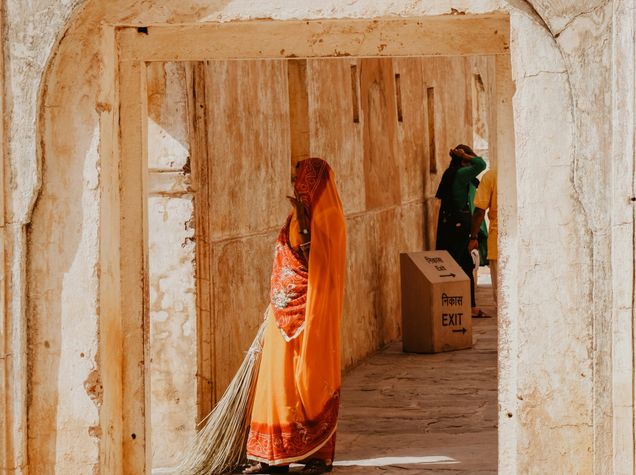Seminar Summary – The Patriarchal Political Order: The Making and Unravelling of the Gendered Participation Gap in India
By Naomi Frim-Abrams

On April 10, 2024, the Human Capital Initiative hosted Soledad Artiz Prillaman for the third Spring Research Seminar, “The Patriarchal Political Order: The Making and Unravelling of the Gendered Participation Gap in India.”
Introduction
Soledad Artiz Prillaman, an Assistant Professor of Political Science at Stanford University and the faculty director of the Stanford Inclusive Democracy and Development Lab, presented her seminar on her recent book, “The Patriarchal Political Order: The Making and Unraveling of the Gendered Participation Gap in India.” The seminar focused on the analysis of qualitative and quantitative data from more than 9,000 women and men in India to expose how coercive power structures diminish political participation for women. The seminar also examined existing programs that aim to bolster women’s agency in the household and push for political representation.
Gendered Participation Gap in India
Prillaman highlighted the gendered discrepancy in non-voting political participation, emphasizing the need to address this gap. She hypothesized that women’s participation is influenced by the costs and benefits perceived by other household members, and that their agency is limited within household political participation decisions. Her research in rural India revealed that men dominate household voting decisions due to patriarchal power imbalances supported by societal norms, legal institutions, and men’s control over household resources. Women often accept household voting decisions to maximize their household’s welfare, but their participation can also be spurred by threats or coercion from male household members.
Methodology and Findings
Prillaman conducted two original surveys in 2016 and 2019, along with semi-structured qualitative interviews with 200 randomly sampled men and women. She used these data to analyze the social and political networks within these communities. The study found that women do not feel they have agency over their voting choices or opportunities for other forms of political participation. The interviews revealed that women face high costs for participating in politics, such as lack of time and care duties. Additionally, almost 20 percent of the women stated that they were explicitly not allowed to attend political meetings, indicating coercion. Prillaman also discovered that political networks primarily include men, with women sitting on the periphery and isolated in pockets throughout the network.
Possible Solutions
Prillaman argued that women will participate more actively in politics when they gain more autonomy in the household and build solidaristic ties with other women that lead to collective action. Her analysis of gender consciousness-raising program interventions within women-only weekly credit collectives supported this argument. Participation in these women’s groups increased non-voting political participation and spurred collective mobilization through policy advocacy. Women who received the gender consciousness-raising programming participated in politics at even higher rates. However, Prillaman emphasized that collective action is costly and faces strong backlash from both male and female community and family members. She highlighted the need for systemic change to fight against gender norms hindering women’s opportunities for political participation.
Discussion and Conclusion
The seminar generated thoughtful questions and conversation from the audience. Prillaman addressed inquiries about the correlation between giving women greater household autonomy and changes in norms, as well as the meaning of “household bargaining.” She concluded by asserting that women achieve autonomy in the household when they gain the ability to contest resistance. This study has strong implications for understanding village governance, women’s patterns of political behavior, and the role of norms, social capital, and legal governance in upholding the patriarchal political order.
SDGs, Targets, and Indicators
1. Which SDGs are addressed or connected to the issues highlighted in the article?
- SDG 5: Gender Equality
- SDG 10: Reduced Inequalities
- SDG 16: Peace, Justice, and Strong Institutions
2. What specific targets under those SDGs can be identified based on the article’s content?
- SDG 5.5: Ensure women’s full and effective participation and equal opportunities for leadership at all levels of decision-making in political, economic, and public life.
- SDG 10.2: By 2030, empower and promote the social, economic, and political inclusion of all, irrespective of age, sex, disability, race, ethnicity, origin, religion, or economic or other status.
- SDG 16.7: Ensure responsive, inclusive, participatory, and representative decision-making at all levels.
3. Are there any indicators mentioned or implied in the article that can be used to measure progress towards the identified targets?
- Indicator for SDG 5.5: Proportion of seats held by women in national parliaments and local governments.
- Indicator for SDG 10.2: Proportion of people who feel safe and secure in their neighborhoods.
- Indicator for SDG 16.7: Proportion of population who believe decision-making is inclusive and responsive.
4. SDGs, Targets, and Indicators
| SDGs | Targets | Indicators |
|---|---|---|
| SDG 5: Gender Equality | Target 5.5: Ensure women’s full and effective participation and equal opportunities for leadership at all levels of decision-making in political, economic, and public life. | Indicator: Proportion of seats held by women in national parliaments and local governments. |
| SDG 10: Reduced Inequalities | Target 10.2: By 2030, empower and promote the social, economic, and political inclusion of all, irrespective of age, sex, disability, race, ethnicity, origin, religion, or economic or other status. | Indicator: Proportion of people who feel safe and secure in their neighborhoods. |
| SDG 16: Peace, Justice, and Strong Institutions | Target 16.7: Ensure responsive, inclusive, participatory, and representative decision-making at all levels. | Indicator: Proportion of population who believe decision-making is inclusive and responsive. |
Based on the article, the issues highlighted are connected to SDG 5 (Gender Equality), SDG 10 (Reduced Inequalities), and SDG 16 (Peace, Justice, and Strong Institutions). The specific targets identified are SDG 5.5 (women’s participation and leadership), SDG 10.2 (inclusion of all), and SDG 16.7 (responsive and inclusive decision-making). The article mentions indicators such as the proportion of seats held by women in national parliaments and local governments (SDG 5.5), the proportion of people who feel safe and secure in their neighborhoods (SDG 10.2), and the proportion of the population who believe decision-making is inclusive and responsive (SDG 16.7).
Source: bu.edu







